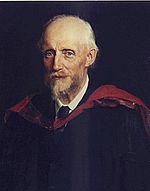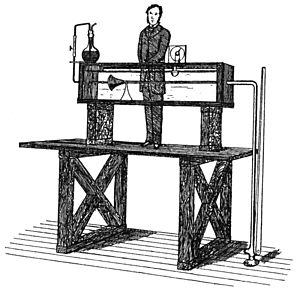Osborne Reynolds facts for kids
Quick facts for kids
Osborne Reynolds
|
|
|---|---|

Osborne Reynolds in 1903
|
|
| Born | 23 August 1842 Belfast, Ireland
|
| Died | 21 February 1912 (aged 69) Watchet, Somerset, England
|
| Nationality | United Kingdom of Great Britain and Ireland |
| Alma mater | Queens' College, Cambridge Victoria University of Manchester |
| Known for | Fluid dynamics, Reynolds number |
| Awards | Royal Medal in 1888 |
| Scientific career | |
| Fields | Physics |
Osborne Reynolds FRS (23 August 1842 – 21 February 1912) was an important scientist from Ireland. He made big discoveries about how liquids and gases move. This field is called fluid dynamics. He also helped improve how heat moves between solids and liquids. This led to better designs for things like boilers and condensers. He spent his whole career teaching and researching at what is now the University of Manchester in England.
Contents
Life and Education
Osborne Reynolds was born in Belfast, Ireland. Soon after, his family moved to Dedham, Essex, in England. His father was a school headmaster and a clergyman. He was also a very good mathematician who loved mechanics. Reynolds' father even got patents for new farm equipment. Osborne Reynolds said his father was his most important teacher when he was a boy.
Early Interests and Experience
Reynolds showed a talent for studying mechanics from a young age. Before going to university, he worked for a year as an apprentice. He worked at the workshop of Edward Hayes, a famous shipbuilder. This was in Stony Stratford. There, he learned how to build and equip coastal steamers. This experience helped him understand how important it was to know about fluid dynamics.
University and Career
Osborne Reynolds went to Queens' College, Cambridge. He graduated in 1867. He was ranked seventh in mathematics, which was a great achievement. After graduating, he worked as a civil engineer in London. He helped with the city's sewage transport system.
In 1868, when he was 25, he became a professor. He was appointed Professor of Engineering at Owens College in Manchester. This college later became the University of Manchester. He was one of the first professors in the UK to have this title. Local factory owners helped create this new professorship. They also played a big part in choosing Reynolds for the job.
Reynolds stayed at Owens College for the rest of his career. In 1880, the college became part of the new Victoria University. He was chosen as a Fellow of the Royal Society in 1877. In 1888, he received the Royal Medal for his work. He retired in 1905. Osborne Reynolds passed away from the flu on February 21, 1912, in Watchet, England.
Understanding Fluid Mechanics
Osborne Reynolds is most famous for studying how fluids move in pipes. He looked at how the flow changed from a smooth, steady movement (called laminar flow) to a chaotic, swirling movement (called turbulent flow).
The Classic Experiment
In 1883, Reynolds showed this change in a famous experiment. He used a glass pipe with water flowing through it. He put a small jet of colored dye into the center of the water flow. At the end of the pipe, there was a valve to control how fast the water moved.
- When the water moved slowly, the colored dye stayed in a clear, straight line through the whole pipe. This showed laminar flow.
- When he made the water move faster, the dye line suddenly broke up. It spread out and mixed with all the water in the pipe. This showed the change to turbulent flow.
The Reynolds Number
From these experiments, Reynolds developed something very important called the Reynolds number. This is a special number that helps scientists predict when a fluid's flow will change from smooth (laminar) to chaotic (turbulent). It compares two types of forces in the fluid:
- Inertial forces: These are forces that keep the fluid moving in its direction.
- Viscous forces: These are forces that resist the fluid's movement, like stickiness or friction within the fluid.
The Reynolds number is the ratio of these two forces. It is used in many areas, from designing airplanes to understanding blood flow in the body.
See also
 In Spanish: Osborne Reynolds para niños
In Spanish: Osborne Reynolds para niños



